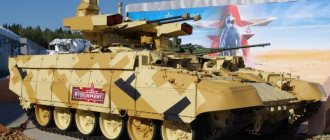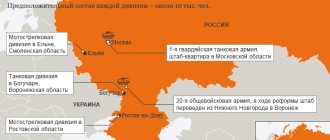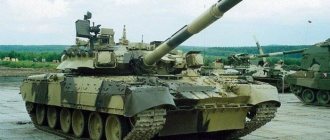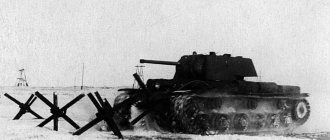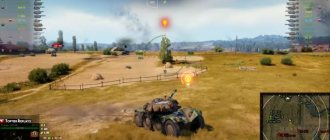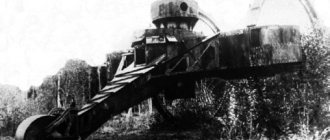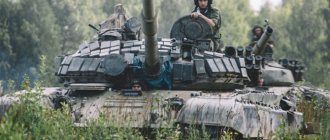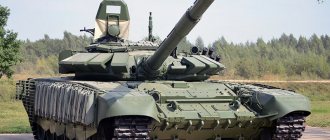According to military experts, in addition to fire support for tanks, the Terminator is suitable for independent operations in the city, desert and mountainous-wooded areas.
According to military experts, in addition to fire support for tanks, the Terminator is suitable for independent operations in the city, desert and mountainous-wooded areas.
Cover from flying
Tanks have a weakness - they are not very effective means of repelling air attacks. But what about the anti-aircraft heavy machine gun that sticks out on the turret of domestic tanks next to the commander’s hatch? Theoretically, he is capable of shooting from a standstill, from short stops, on the move. Almost... Once, while watching the qualifying competitions for tank biathlon, I was amazed at how much time it took to prepare this heavy machine gun for firing and then return it to its transport position. And, which is typical, the crew commander performs all the manipulations by leaning out with the hatch open. It will do for biathlon. What if in real combat conditions under enemy fire? The conclusion suggests itself - a heavy machine gun is effective if it is already ready to fire. That is, tankers have long been expecting an attack from the air. In the event of a sudden raid, there will not be enough time to repel the attack, and the commander sticking out of the open hatch is an excellent target. It seems that the time of manually controlled anti-aircraft machine guns has already passed. And that's why.
In the front part of the hull, AGS-17D directional grenade launchers are installed in the fender niches.
In the front part of the hull, AGS-17D directional grenade launchers are installed in the fender niches.
BMPT "Terminator": a successful failure?
At the end of March this year, the Uralvagonzavod Research and Production Corporation announced the completion of assembly and testing of the first batch of Terminator tank support/fire support combat vehicles. 10 production vehicles were sent to the customer and became the first examples of their type in the Russian army. In the foreseeable future, new deliveries will take place, with the help of which the required fleet of equipment will be formed. Despite such successes, the BMPT project is still controversial.
The main reason for the ongoing controversy is the fact that the Terminator - like any other piece of military equipment - has not only positive features, but also disadvantages or ambiguous features. This contributes to the start of the most active discussions, and fundamental decisions of the military, such as the adoption of equipment for service, only exacerbate disputes. Let's try to figure out what claims are being made against the BMPT, and what it can say in its defense.
Are there negatives all around?
Russian projects of the Terminator family BMPT are based on fairly simple but interesting ideas. It is proposed to equip the serial tank chassis with a special turret and an updated weapon system. Instead of a tank gun and a set of machine guns, it is proposed to use a pair of automatic cannons, a machine gun, automatic grenade launchers and guided missiles. It is argued that such a weapon system allows a combat vehicle to fight a variety of targets, choosing the most effective in a given situation.
The first complaint about the Terminator concerns the level of protection of the vehicle and its individual components, which directly affects combat survivability. All models of the family are based on a tank chassis: for example, a production vehicle for the Russian army is built on the basis of the T-90 tank. This chassis has combined frontal armor covered with dynamic protection units. In general, the level of protection of the body of such a “Terminator” corresponds to existing tanks and is capable of withstanding fire from various weapons, including quite powerful ones.
However, the turret of this armored vehicle, apparently, is seriously inferior in terms of protection to the hull. All weapon systems and fire control equipment are located inside armored casings, but it is obvious that they are only capable of protecting against bullets, shrapnel and small-caliber projectiles. The layout of the weapon also does not contribute to increased survivability. Gun barrels and containers with anti-tank missiles are located outside the turret. However, the new project provides additional covers to protect them.
Thus, domestic Terminators protect their crew well, but at the same time expose their weapons and ammunition to great risks. This means that under certain circumstances during a battle, an armored vehicle runs the risk of losing part of its most powerful weapons from enemy fire with a known drop in combat qualities.
According to the engineers, to combat manpower or unprotected targets, the BMPT can use the PKTM machine gun and AG-17D automatic grenade launchers. Lightly armored vehicles or buildings can be attacked with two 30 mm 2A42 cannons. In case of a meeting with tanks, the Terminator carries four Ataka-T missiles. Depending on the weapon used, the armored vehicle is capable of attacking targets at ranges from hundreds of meters to 6-8 km.
The existing weapon system looks interesting and very effective, but it can also be criticized. For example, the topic of the claim could be an existing missile system. It is assumed that with its help, the BMPT will be able to help tankers in the fight against enemy tanks, destroying some targets at long distances. However, the Terminator's ammunition consists of only four missiles. Thus, after just a few launches, the armored vehicle will be able to fight the most serious threat only with the help of automatic guns, the effectiveness of which will be insufficient.
In the context of guided and artillery weapons, the BMPT is sometimes compared to modern main battle tanks, and such a comparison is usually not in its favor. Thus, when fighting armored vehicles, any serial domestic tank has the ability to “meet” the enemy with guided missiles, and after approaching a sufficient distance, use armor-piercing shells. In case of a collision with infantry or lightly armored vehicles, the tank has high-explosive fragmentation rounds and machine guns.
According to known data, the Terminator BMPT is equipped with a modern fire control system that meets current requirements and is built using “tank” devices. In particular, the commander and gunner have at their disposal combined sights with a day and night channel, as well as a laser rangefinder. The gunner's sight is located in front of the main part of the turret and is designed to track the front hemisphere. The commander, in turn, must use a panoramic sight.
The devices used allow you to monitor the situation, search for targets and aim the main weapon, but even here you can find weak points. First of all, the Terminator sights have rather weak protection and therefore are unlikely to have high combat survivability. However, many other modern armored vehicles have similar problems. Another specific point is the lack of special advantages over the devices of serial tanks. As a result, the BMPT, working in the same order as tanks, will not be able to find targets earlier and faster.
This may negatively affect both the Terminators’ own work and joint actions with tanks. The fact is that modern anti-tank missile systems can have an increased firing range, exceeding the capabilities of the optics and small arms of serial tanks. In this case, their detection and destruction becomes the task of the BMPT, but their potential in this matter may be limited. Fortunately, such problems can only occur in the area of detection tools. The presence of a pair of automatic cannons guarantees the successful destruction of the found complex along with crews and vehicles over a wide range of ranges.
According to various sources, the BMPT in its latest version, which became the subject of a contract between Uralvagonzavod and the Ministry of Defense, is characterized by a fairly high cost - which also cannot be called an advantage. Due to the use of diverse weapons and special control systems, as well as the results of other innovations in the project, the finished “Terminator” costs more than the serial T-90 tank on the basis of which it is being built.
Strange concept
It is worth recalling that the domestic tank support combat vehicle was first introduced back in the late nineties, but for almost two decades it could not enter service with the Russian army. Until a certain time, the reason for this was the ambiguity of the concept and the lack of an appropriate tactical niche in existing strategies. In other words, the military simply could not find a place for the “Terminator” in the troops. And this can also be considered a problem with the BMPT.
For several decades, the task of infantry fire support was assigned primarily to tanks. At the same time, the soldiers, supported by the fire of armored vehicles, had to protect the tanks from tank-dangerous targets. In such a system, the task of supporting infantrymen could also be performed by infantry fighting vehicles and armored personnel carriers. The BMPT concept was based on similar ideas, but did not fit into existing views on the organization of combined arms combat. It turned out that the Terminator is a tank support vehicle, which, in turn, is designed to support infantry. It all seemed overly complicated and expensive, but it didn't seem to provide any benefits.
As a result, for a long time, BMPT projects remained without real prospects. However, by the end of the 2000s, a fundamental decision was made to adopt Terminators for service. Subsequently, new difficulties arose, which is why these plans were not implemented. The first contract for the supply of new equipment was signed only last year, and production vehicles went to the troops just a couple of months ago.
The Tank Support/Fire Support Combat Vehicle is finally entering the Russian Armed Forces and adding to the fleet of only a few units so far. At the same time, disputes about such technology do not stop. Their continuation is facilitated by the preservation of the characteristic features of the car, which from certain points of view may look like shortcomings. However, the army has already made its choice and nevertheless decided to begin operating the unusual equipment.
Word for practice
You can consider the “pure” appearance and technical characteristics of armored vehicles as much as you like, as well as perform thought experiments, but practice will still remain the criterion of truth. And in this regard, “The Terminator” has already managed to show its best side. Over the course of several years, prototypes of a number of modifications underwent various tests at testing grounds. Then the improved equipment, having undergone the necessary fine-tuning, went to the real war.
In 2022, the Terminator was sent to Syria to be tested in a real armed conflict. At the same time, the technology had to solve problems that differed in some way from those included in its name. Since the Syrian army and its opponents do not engage in large-scale tank battles, the BMPT was planned to be used as a means of fire support for infantry. In practice, it has been shown that the existing combination of tank armor, cannon, machine gun and missile weapons makes it possible to solve a wide range of combat missions within the framework of a local conflict.
As far as we know, it was the results of the operation of Terminators in Syria that became one of the main reasons for the adoption of such equipment into service. In August last year, a contract appeared for serial production and supply of new combat vehicles. The first batch of such equipment was handed over to the customer at the end of March. In the near future, the remaining vehicles will be transferred to the army, and no later than 2019, the contract will be fully implemented.
The events surrounding the Terminator project, observed recently, actually put an end to many years of controversy. During testing and experimental military operation in a hot spot, it was established that such equipment is suitable for service and can be ordered for the army. Among other things, this means that various specific features of the BMPT, which could be considered disadvantages, in fact are not such. The combat vehicle meets the requirements of the battlefield and can find a place in the Russian armed forces.
Question of the future
While the Russian army was deciding whether it needed the Terminator, the designers of the Uralvagonzavod Research and Production Company did not waste time. In recent years they have offered a whole family of tank support/fire support combat vehicles. All of these projects are based on common ideas, but use different components. First of all, several Terminators differ in the type of base chassis. Some of these projects have already been implemented in metal and brought to testing, while others are still waiting in the wings.
Initially, the BMPT was developed on the basis of the T-90 main tank. After a number of changes, this particular version of the armored vehicle went into production and is being supplied to the troops. Also, a few years ago, Uralvagonzavod presented a modification of the Terminator based on the T-72 tank chassis. Despite certain changes of one kind or another, the main features of the technology remained the same. To promote the projects on the market, several prototypes were built on different chassis, regularly demonstrated at various exhibitions.
A few years ago, plans were announced to create a new version of the Terminator. This time they plan to install a turret with a variety of weapons on an Armata-type chassis. To date, a unified tracked platform of this type has become the basis for a tank, a heavy infantry fighting vehicle and a repair and recovery vehicle. In the future, it is planned to continue the development of the family, creating new models of equipment. One of them will be a tank support/fire support combat vehicle.
Perhaps the new project of the family will provide for a significant increase in firepower. So, a pair of 30 mm cannons can be replaced by one 57 mm machine gun. This will improve the basic firing qualities of the vehicle, as well as increase the effective firing range and expand the range of targets hit. However, this project is still in its early stages and the development company probably cannot yet present a prototype or its layout.
One way or another, the Terminator BMPT, after many years of uncertainty, was finally able to get into service with the troops. So far, the plans of the military department do not provide for the purchase of such equipment in large quantities, but in the future the situation may change. At the same time, the project is developing, which leads to the emergence of new modifications. What will be the fate of these BMPT variants is still anyone's guess. However, it is obvious that the latest successes of the existing Terminators will have a positive impact on the further development of the family.
Based on materials from the sites: https://uralvagonzavod.ru/ https://mil.ru/ https://ria.ru/ https://tass.ru/ https://rg.ru/ https://gazeta. ru/ https://gurkhan.blogspot.com/
History of creation
The idea of developing the BMPT was dictated by combat tactics, which were often used during the Second World War. Then self-propelled anti-aircraft guns were used to carry out fire support tasks - a new type of weapon for those years. American M-17 anti-aircraft guns were supplied to the USSR under Lend-Lease. They were a quad machine gun based on a wheeled-tracked chassis. The 80s for our country were marked by the conflict in Afghanistan. Let's be honest, military equipment was hardly suitable for counterinsurgency warfare.
- Firstly, delivering this equipment to the mountains is very problematic.
- Secondly, the installation angle of the tank guns was so high that fire on enemy positions located in the mountains was ineffective.
Only the BMP-2, equipped with an automatic 30-mm cannon, and the Shilka self-propelled gun did not experience any particular difficulties. But the bets on these machines were low, since there was a huge gap in terms of protection. They were protected only by light armor, so our army lost a lot of equipment in the mountains. The military conflict in the DRA clearly showed the need of the armed forces for combat vehicles, the level of protection of which would be comparable to that of a tank, and whose versatility and maneuverability would allow them to effectively suppress tank-dangerous infantry. In 1989, three prototype BMPT units were assembled at the Chelyabinsk Tractor Plant on the T-72 tank chassis.
The presented BMPT samples differed in their equipment. One model was equipped with a 100 mm gun, and the rest of the vehicles were equipped with a pair of 30 mm guns. The collapse of the Soviet Union put an end to the project, since the design bureau working at the Chelyabinsk Tractor Plant was abolished.
The 90s are considered the most difficult years for the Russian Federation. This includes a series of economic crises, division of spheres of influence, internal political strife and, naturally, the war in Chechnya. The assault on Grozny came at a great price. Federal troops suffered huge losses. The Tunguska self-propelled gun, used as a tank cover vehicle, did not bring the desired effect. Since the Chechen conflict dragged on, the project to create a BMPT had to be remembered again, but now it was being developed at Uralvagon.
The second name of the development is “Object 199”. It was under this name that the first prototype of the machine was presented in 2000. Several copies participated in state tests and successfully completed them by 2006. After these tests, the name “Terminator” was firmly assigned to the machines, displacing the original “Frame”.
Tactical and Technical Characteristics
The performance characteristics of the BMPT Terminator look like this:
- The layout is classic;
- Number of crew members – 5 people;
- Developer – UKBTM;
- named after F.E. Dzerzhinsky";
- Years of production – since 2001;
- Years of operation – since 2011;
- Machine weight – 48 tons;
- Dimensions (length (length with gun) x width x height) – 6960 mm (7200 mm) x 3800 mm x 3440 mm;
- Track width – 3370 mm;
- Tower roof height – 1940 mm;
- Type of armor - projectile-proof, with dynamic protection, rolled and cast, combined;
- Gun – 2A42;
- Gun caliber – 30 mm;
- Gun ammunition - 900 rounds;
- Vertical guidance angle – from -5 to 45 degrees;
- Horizontal guidance angle – 360 degrees;
- Firing range (manpower/lightly armored vehicles/aerial targets) – 4000 m/1500 m/2000 m;
- Gunner's sight - with optical and thermal imaging channels, laser-beam missile control channel and range finder;
- The commander's sight has a thermal imaging channel and a laser rangefinder;
- Grenade launcher sight - day/night "Agat-MP";
- Navigation system – GLONASS;
- Machine gun – PKTM;
- Caliber – 7.62 mm;
- Ammunition - 2000 rounds;
- Other weapons - PU KUV "Ataka-T" - 4 UR 9M120-1, AG-17D;
- Engine - V-92S2;
- Engine power – 1000 hp.
- Maximum speed – 65 km/h;
- Power reserve – 550 km.
In terms of tactical and technical characteristics, the Terminator BMPT did not become the most powerful vehicle in the world. It is noted that some infantry fighting vehicles are armed more effectively. For example, the Swedish CV-90 has a 40-mm Bofors gun in its arsenal. The question rightfully arises as to why our vehicles were not equipped with such a weapon, because it would have been possible to win not only in rate of fire, but also in range, as well as in the radius of destruction.
In fact, there simply were no such weapons in the USSR at that time. It is expected that even before the release of Terminator-3, a deep modernization of the BMPT-72 weapons will be carried out.
